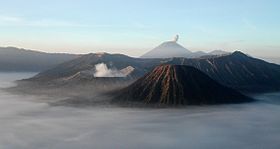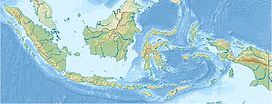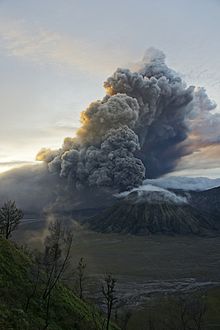- Mount Bromo
-
Mount Bromo 
Mt. Bromo (large crater, foreground) at sunriseElevation 2,329 m (7,641 ft) [1] Listing Spesial Ribu Location Java, Indonesia Coordinates 7°56′30″S 112°57′00″E / 7.94167°S 112.95°ECoordinates: 7°56′30″S 112°57′00″E / 7.94167°S 112.95°E[1] Geology Type Stratovolcano Last eruption 28 January 2011[2] - For the main article that includes the Sand Sea and the Mount Semeru area, see Bromo Tengger Semeru National Park.
Mount Bromo (Indonesian: Gunung Bromo), is an active volcano and part of the Tengger massif, in East Java, Indonesia. At 2,329 metres (7,641 ft) it is not the highest peak of the massif, but is the most well known. The massif area is one of the most visited tourist attractions in East Java, Indonesia. The volcano belongs to the Bromo Tengger Semeru National Park. The name of Bromo derived from Javanese pronunciation of Brahma, the Hindu creator god.
Mount Bromo sits in the middle of a vast plain called the "Sea of Sand" (Javanese: Segara Wedi or Indonesian: Lautan Pasir), a protected nature reserve since 1919. The typical way to visit Mount Bromo is from the nearby mountain village of Cemoro Lawang. From there it is possible to walk to the volcano in about 45 minutes, but it is also possible to take an organised jeep tour, which includes a stop at the viewpoint on Mount Penanjakan (2,770 m or 9,088 ft) (Indonesian: Gunung Penanjakan). The best views from Mount Bromo to the Sand Sea below and the surrounding volcanoes are at sunrise. The viewpoint on Mount Penanjakan can also be reached on foot in about two hours. From inside the caldera, sulfur is collected by workers.
Depending on the degree of volcanic activity, the Indonesian Centre for Vulcanology and Disaster Hazard Mitigation sometimes issues warnings against visiting Mount Bromo. The list of outstanding warnings may be consulted at the Indonesian-language website of the Centre.
Contents
Culture
On the fourteenth day of the Hindu festival of Yadnya Kasada, the Tenggerese people of Probolinggo, East Java, travel up the mountain in order to make offerings of fruit, rice, vegetables, flowers and sacrifices of livestock to the mountain gods by throwing them into the caldera of the volcano. The origin of the ritual lies in the 15th century legend where a princess named Roro Anteng started the principality of Tengger with her husband, Joko Seger. The couple were childless and therefore beseeched the assistance of the mountain gods. The gods granted them 24 children but stipulated that the 25th child, named Kesuma, must be thrown into the volcano as human sacrifice. The gods' request was implemented. The tradition of throwing sacrifices into the volcano to appease these ancient deities continues today and called Yadnya Kasada ceremony. Though fraught with danger, some locals risk climbing down into the crater in an attempt to recollect the sacrificed goods that believed could bring them good luck.
On the Segara Wedi sand plain sits a Hindu temple called Pura Luhur Poten. The temple holds a significant importance to the Tenggerese scatter across the mountainous villages such as Ngadisari, Wonokitri, Ngadas, Argosari, Ranu Prani, Ledok Ombo and Wonokerso. The temple organized annual Yadnya Kasada ceremony which lasts for about one month. On the 14th day, the Tenggerese will congregate at Pura Luhur Poten to ask for blessings from Ida Sang Hyang Widi Wasa and God of Mahameru (Mount Semeru). Then the mass will proceed along the crater edges of Mt Bromo where offerings will be thrown into the crater. The major difference between this temple with the Balinese ones are the type of stones and building materials. Pura Luhur Poten uses natural black stones from volcanoes nearby, while Balinese temples mostly made from red bricks. Inside this pura, there are several buildings and enclosures aligned in Mandala zone composition.[3]
Activity
2004 eruptions
Mount Bromo erupted in 2004, that eruptive episode led to the death of two people.[citation needed]
2010 eruptions
On Tuesday, 23 November 2010, 16.30 WIB (Western Indonesian Time), the Indonesian Centre of Vulcanology and Geology Hazard Mitigation (CVGHM) confirmed the activity status of Mount Bromo at "alert" due to increasing tremor activity and shallow volcanic earthquakes at the mountain.[4] Concerns were raised that a volcanic eruption may be likely to occur. As a precaution local residents and tourists were instructed to remain clear of an area within radius three kilometres from the caldera and refugee encampments were erected. The area surrounding the Teggera caldera of Bromo remained off limits for visitors throughout the remaining part of 2010.
Bromo started to erupt ash on Friday 26 November 2010.[5]
On 29 November 2010 Transport Ministry spokesman Bambang Ervan announced that Malang's domestic airport, would be closed until 4 December 2010. Malang a city of about 800,000 people is about 25 km (16 mi) west of Mount Bromo. Abdul Rachman Saleh Airport IATA:MLG normally handles 10 daily domestic flights from the capital Jakarta. Government volcanologist Surono reported that the volcano was spitting columns of ash some 700 metres (2,300 feet) into the sky.[6]
2011 eruptions
The Tengger Caldera was still active in late January 2011, the activity being characterised by fluctuating ongoing eruptions. On 23 January 2011 the Indonesian Centre for Volcanology and Geological Hazard Mitigation (CVGHM) (Pusat Vulkanologi dan Mitigasi Bencana Geologi) reported that since 19 December, 2010 volcanic ash and incandescent material had been thrown up by eruptive activity resulting in a heavy rain of material that fell around the crater. Continuous eruptions on 21 January caused a thin ash fall mainly in the village areas of Ngadirejo and Sukapura Wonokerto in Probolinggo district. The impact of a heavy rain of volcanic ash from eruptions since 19 December 2010 resulted in disruption of normal activities. By early 2011 concerns were being raised concerning the effect upon the local economy and the potential for long term environmental and health problems amongst the residents in the locality surrounding Mount Bromo. Due to high seasonal rainfall in January 2011 the potential for lahar and lava flow was raised due to the deposits of volcanic ash, sand and other ejected material that had built up. Seismic activity was dominated by tremor vibration and reports of visual intensity and sounds of eruption continued to be reported from the mountain monitoring facility, Bromo Observation Post. People living on the banks of the Perahu Ravine, Nganten Ravine and Sukapura River were alerted to the possibility of lava flows, especially when it was raining heavily in the area around Cemorolawang, Ngadisari and Ngadirejo. Eruptions and volcanic tremors were reported on 21 January and 22 January with activity subsiding on 23 January 2011. On 23 January, 2011 at 06:00 am the alert status at Mount Bromo remained at (Level III).[7]
On 23 January 2011 an exclusion zone was recommended for communities living around Mount Bromo. Tourists and hikers were to advised not to come within a radius of 2 km from the active crater. CVGHM stated that they expected warning signs to be installed stating the limit radius of 2 km from the crater. Operational caution was recommended for flights into and leaving Juanda International Airport IATA:SUB in Surabaya. CVGHM recommended the establishment of public areas for the provision of face masks and eye protection. CVGHM also issued a warning to residents to be cautious of ash build up on roofs and other places that may give cause for collapse under the burden of ash.[8]
Further eruptions and the issuing of Aviation Ash advisories on 27 January and 28 January 2011 led to concerns being raised regarding a volcanic ash plume, reported to be drifting eastward toward the air corridors used to access the Ngurah Rai International Airport IATA:DPS in Bali. Airport official Sherly Yunita was reported at the time as stating that concerns about visibility had prompted Singapore Airlines, Jetstar-ValueAir, Air France-KLM, Virgin Blue and Cathay Pacific to cancel several flights to Bali, 340 km (210 mi) to the east.[9][10] SilkAir also cancelled flights on the 27 January between Singapore and Lombok, an island to the east of Bali.[11] The Volcanic Ash Advisory Centre in Darwin, Australia released several Code Red Aviation Ash Advisories pertaining to Mount Bromo (Tengger Caldera), on 27 January. They indicated that ash was observed at altitudes up to 18,000 ft (FL180) extending 200 nautical mi to the south east of the caldera. In other ash advisories of that day the cloud was reported as at times having a 10 km/h drift, both to the east, and to the south east.[12]
Deformation-late November 2010-late January 2011
- Tiltmeter
- The Indonesian Centre for Volcanology and Geological Hazard Mitigation (CVGHM) reported on 13 January 2011, that deformation using tiltmeter measurements indicated an inflation at rate of 5 micro radians between 25 November 2010 and 14 December 2010 and a relatively stable since 15 December, 2010 both on Radial Components and Tangential Components.
- EDM
- Deformation measurement using EDM compared observations at designated measuring points; POS-BRO, POS-KUR and POS-BAT during the period 25 November 2010 - 20 December 2010 with observations from the period 21 December 2010 - 30 December 2010 indicated the shortening of the distance from the POS-BAT, or inflation. Observations between 30 December 2010 to 23 January 2011 were reported as relatively stable.[13]
Gallery
See also
References
- ^ a b "Tengger Caldera". Global Volcanism Program, Smithsonian Institution. http://www.volcano.si.edu/world/volcano.cfm?vnum=0603-31=. Retrieved 2010-03-10.
- ^ http://www.bom.gov.au/products/Volc_ash_recent.shtml
- ^ Pura Luhur Poten
- ^ BBC Indonesia Bromo Alert "Bromo alert-unconfirmed title". 10 november 2010. http://www.bbc.co.uk/indonesia/berita_indonesia/2010/11/101123_bromoalert.shtml BBC Indonesia Bromo Alert. Retrieved unknown-article no longer available.
- ^ "unknown title". Yahoo News. 27 November 2010. http://news.yahoo.com/s/afp/20101127/wl_asia_afp/indonesiavolcano_20101127073140. Retrieved unknown-no longer available.
- ^ "Volcano closes Indonesia airport". Bangkok Post. 29/11/2010. http://www.bangkokpost.com/breakingnews/208717/indonesia-closes-airport-as-volcano-rumbles. Retrieved 27 January 2011.
- ^ "Evaluation of the status and alert level of Mount Bromo on 23 January 2011 at 0600 hrs - (Hasil evaluasi kegiatan G. Bromo dalam status SIAGA, sampai dengan 23 Januari 2011 Pkl. 06.00 WIB)". 24 January 2011 (15:57).
- ^ "Evaluation of the status and alert level of Mount Bromo on 23 January 2011 at 0600 hrs - (Hasil evaluasi kegiatan G. Bromo dalam status SIAGA, sampai dengan 23 Januari 2011 Pkl. 06.00 WIB)". 24 January 2011 (15:57).
- ^ "Volcano in central Indonesia disrupts flights". The Associated Press. 27 Jan, 2011. http://www.hometownstations.com/Global/story.asp?S=13917512. Retrieved 27 January 2011.
- ^ Reuters (2011). "Airlines cancel flights to Bali as Indonesia volcano erupts". Yahoo News. http://news.yahoo.com/s/nm/20110127/wl_nm/us_indonesia_volcano_1. Retrieved 27 January 2011.
- ^ Leong Wee Keat (28 January 2011). "Mount Bromo eruption disrupts flights to Bali, Lombok". Today On-line, Singapore. http://www.todayonline.com/Singapore/EDC110128-0000230/Mount-Bromo-eruption-disrupts-flights-to-Bali,-Lombok. Retrieved 28 January 2011.
- ^ "Volcanic Ash Advisories Received in Last 7 Days". Australian government Bureau of Meteorology (VAAC)-ADVISORY#FVAU0190. 15:25 UTC, 27/01/2011. http://www.bom.gov.au/products/Volc_ash_recent.shtml. Retrieved 27 January 2011.
- ^ "Evaluation of the status and alert level of Mount Bromo on 23 January 2011 at 0600 hrs - (Hasil evaluasi kegiatan G. Bromo dalam status SIAGA, sampai dengan 23 Januari 2011 Pkl. 06.00 WIB)". 24 January 2011 (15:57).
External links
Categories:- Stratovolcanoes
- Subduction volcanoes
- Volcanoes of Java
- Mountains of Indonesia
- East Java
- Active volcanoes of Indonesia
Wikimedia Foundation. 2010.






